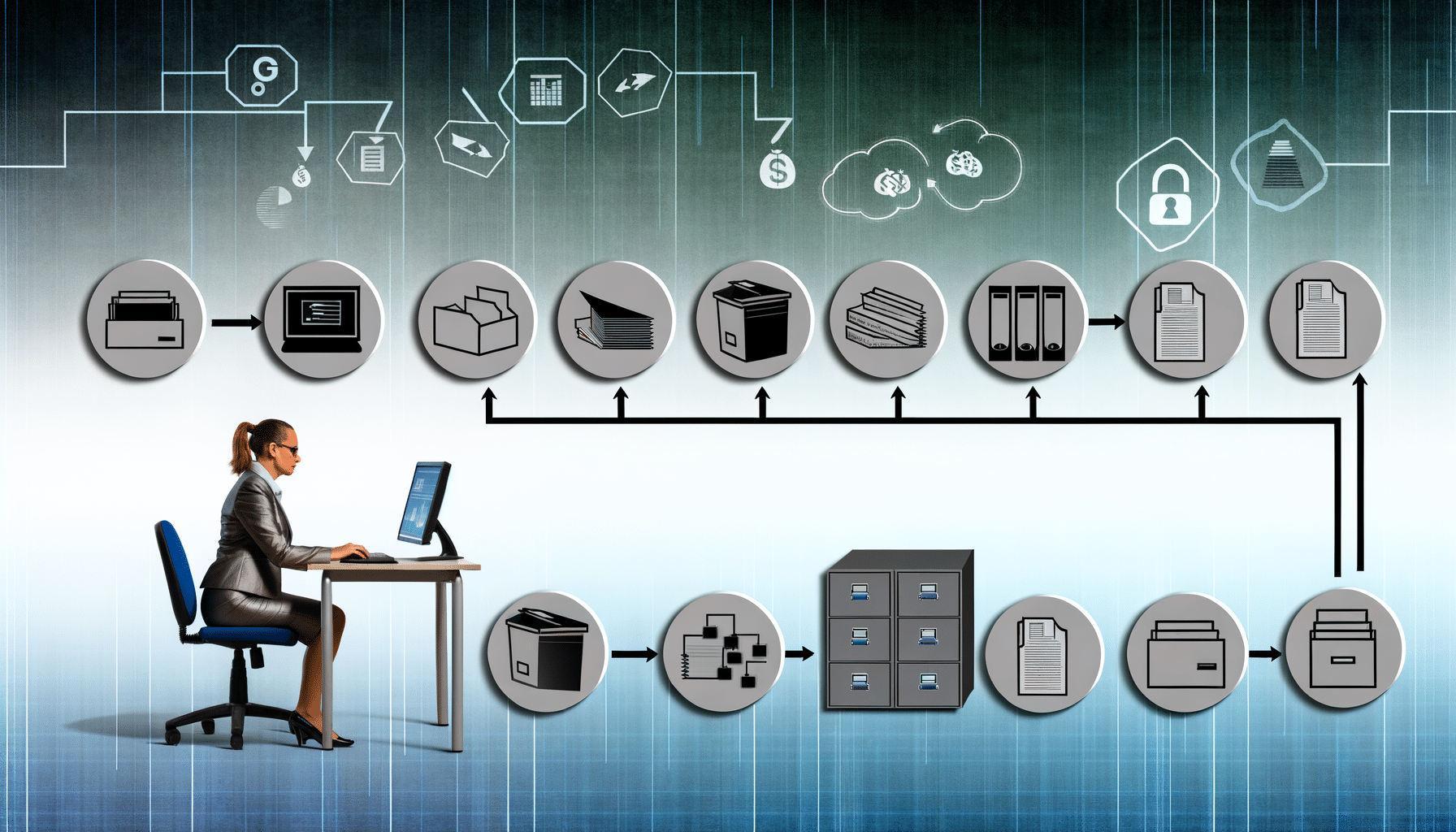- Record Lifecycle
- March 7, 2024
Understanding the Lifecycle of Financial Records: From Creation to Disposal

Mastering the Lifecycle of Financial Records: A Guide for Record Management Professionals
As someone deeply involved in the fusion of technology and records management, I’ve witnessed the transformative power of effective record-keeping. In this article, I’ll be sharing insights on managing the lifecycle of financial records—an area where meticulous management can spell the difference between operational excellence and chaos.
Understanding the Lifecycle of Financial Records
The lifecycle of financial records encompasses several key stages: creation, active use, semi-active storage, and eventual disposal. These stages define how records are treated from the moment they’re generated until they’re either archived or destroyed. Let’s explore each stage in detail.
1. Creation: Setting the Foundation
Financial records are born out of every business transaction—whether a simple invoice or a complex tax document. The creation phase involves generating, capturing, and storing these documents accurately. The challenge here is to ensure that the records are created with complete, accurate, and traceable information.
Automated solutions like AI can significantly aid in this stage by minimizing human error during data entry and ensuring consistency across records. As we continue to innovate at RecordsKeeper.AI, our focus remains on deploying technologies that enhance precision from the point of creation.
2. Active Use: The Operational Phase
Once created, financial records are actively used for various purposes—ranging from routine operations to audits and financial reporting. This stage demands quick and reliable access to records with secure retrieval systems in place.
An emphasis on organized, easily accessible records cannot be overstated. This is where the magic of AI comes into play. Automated categorization and tagging allow you to retrieve records seamlessly through natural language queries, freeing individuals from the tedious task of manual searching.
3. Semi-Active Storage: Bridge to Archival
During the semi-active stage, records continue to hold value but are not as frequently accessed. Storage efficiency becomes paramount here. Businesses must determine which older records hold operational value and which do not.
Immutable archival through blockchain technology ensures data integrity while reducing redundancy. Our design at RecordsKeeper.AI incorporates smart decision-making tools to help navigate these decisions effortlessly.
4. Disposal: Saying Goodbye Securely
Every record reaches an expiry date, which is where the disposal phase comes in. Disposal isn’t just about getting rid of outdated documents; it’s about ensuring secure, compliant destruction of records. Adherence to compliance standards like GDPR and HIPAA is critical at this stage to avoid penalties and safeguard sensitive information.
Policy Management tools in our platform are designed to automatically enforce these data retention and deletion protocols, allowing businesses to focus on growth rather than administrative burdens.
Creating a Strategic Framework with Modern Solutions
Navigating through these stages with precision requires a strategic approach backed by modern solutions. RecordsKeeper.AI is dedicated to transforming the record management landscape by leveraging AI and blockchain, providing an efficient platform that meets contemporary demands.
Some advantages our platform offers include:
By embracing decentralized and secure technologies, businesses can confidently manage the lifecycle of financial records, bolstering their operational resilience and steadfast compliance.
The Role of Legal, Finance & Compliance Heads
For legal, finance, and compliance professionals, understanding these lifecycle stages and the associated tools is essential. Your role in ensuring regulatory adherence and data security can significantly influence your organization’s credibility and efficiency. By adopting cutting-edge technologies, you can wield record management as a competitive advantage.
Imagine a world where record-keeping is no longer a cumbersome task but a streamlined process—this is the promise we carry forward at RecordsKeeper.AI.
Conclusion: Embrace the Future of Record Management
In closing, mastering the lifecycle of financial records can redefine how you operate within your organization. It’s crucial to leverage advanced solutions like RecordsKeeper.AI to transform record management from a difficult task into a strategic advantage.
If you’re ready to modernize your approach to handling financial records or wish to dive deeper into the world of AI and blockchain applications, I invite you to explore our offerings. Stay connected for more insights as we continue to innovate and simplify the way records are handled. Let’s focus on what truly matters—leading with precision and foresight.
I look forward to sharing more insights and experiences in the future. Together, let’s shape a world where record management contributes seamlessly to our overarching goals of security, compliance, and operational excellence.
Toshendra Sharma is the visionary founder and CEO of RecordsKeeper.AI, spearheading the fusion of AI and blockchain to redefine enterprise record management. With a groundbreaking approach to solving complex business challenges, Toshendra combines deep expertise in blockchain and artificial intelligence with an acute understanding of enterprise compliance and security needs.
Archives
- January 2025
- December 2024
- November 2024
- October 2024
- September 2024
- August 2024
- July 2024
- June 2024
- May 2024
- April 2024
- March 2024
- February 2024
- January 2024
- December 2023
- November 2023
- October 2023
- September 2023
- August 2023
- July 2023
- June 2023
- May 2023
- April 2023
- March 2023
- February 2023
- January 2023
- December 2022
- November 2022
- October 2022
- September 2022
Want to get more content like this?
Signup to directly get this type of content to your inbox!!
Latest Post
Document Control for Equipment Maintenance
- January 20, 2025
Managing Records for Multiple Clients
- January 19, 2025
Handling Conference Documentation
- January 18, 2025
Setting Up Department Record Reviews
- January 17, 2025





